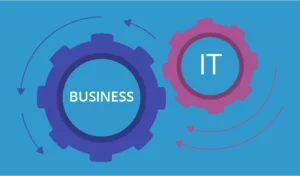Enterprise architecture (EA) provides a comprehensive blueprint to align an organization’s business strategy with technology, data, and other capabilities. EA frameworks are important for taking a holistic, strategic view to coordinate across business units, manage change, and optimize the IT landscape.
While IT professionals often focus on the technical aspects, EA is much more than just networks and applications. Effective enterprise architects take a wide lens encompassing business objectives, governance, capabilities, processes, data, and more. They bridge the gap between business leaders and technologists to enable strategic transformation and innovation.
An EA framework gives structure for architects to analyze and optimize the current environment, while planning future states aligned to business goals. Framework methodologies guide comprehensive documentation of the enterprise, facilitating communication and decision making company-wide. This strategic role makes EA instrumental for managing complexity, risk, costs, and opportunity.
Leading EA frameworks provide concrete strategies to develop target architectures, roadmaps, and recommendations that accelerate business value. This content will explore popular frameworks and how to apply them consulting engagements. With the right knowledge and expertise, enterprise architecture can be a powerful business enabler.
Business & IT Alignment
Achieving alignment of business strategy and IT infrastructure is a key goal for many enterprises. This ensures that technology investments and systems support overarching business objectives. However, sustaining alignment can be challenging, as business strategies evolve while technical debt and legacy systems persist.
Enterprise Architecture provides a framework for business and IT alignment by taking a holistic view of the organization. However, sustaining alignment can be challenging, as business strategies evolve while technical debt and legacy systems persist. In such scenarios, seeking guidance from experienced professionals in enterprise architecture consulting services can be invaluable. The EA program links strategic business goals with capabilities, processes, and systems. This enables informed planning and decision-making to evolve the technology landscape in sync with changing business needs.
Some ways Enterprise Architecture enables business and IT alignment:
- Provides visibility into the current technology portfolio and infrastructure
- Maps business capabilities and requirements to specific systems and applications
- Identifies duplication and redundancy to rationalize solutions
- Defines principles and standards to guide technology decisions
- Informs roadmaps, migration plans, and investment priorities
- Supports portfolio management, planning, and execution
- Ensures solutions meet business needs while optimizing value
- Allows adapting to new innovations and directions from leadership
With a strong EA practice, organizations can develop IT systems and architectures that trace directly back to business objectives. This linkage enables responsive realization of strategy through technology capabilities. EA becomes the common thread that connects business and IT planning horizons.
Holistic View
Enterprise architecture takes a holistic view of the organization, providing a comprehensive understanding of the business, applications, data, and technology landscape. Rather than focusing on individual parts in isolation, EA examines how all the components work together as an integrated system to enable business capabilities and strategy.
This big picture perspective is crucial for aligning business and IT, managing complexity, and enabling organizational agility. By mapping out interconnections and dependencies between business units, processes, applications, data, and infrastructure, EA brings clarity to the current state environment. This holistic view reveals duplication, gaps, and opportunities for standardization, integration, and consolidation.
With a clear understanding of the as-is state, EA can then develop the future state architecture aligned to business goals. The holistic approach ensures changes in one area, such as new technologies, don’t create misalignment or unintended consequences in other parts of the organization. EA connects strategy to execution through comprehensive roadmaps that transition the enterprise from current to future state in a coordinated, business-driven manner.
Overall, the holistic perspective provided by EA is essential for managing complexity, enabling change, and gaining technology advantage in today’s dynamic business environment. By taking a systemic approach, EA helps organizations move forward in an integrated fashion for greater agility, efficiency and innovation.
Governance
Enterprise architecture plays a critical role in enabling effective IT governance and ensuring compliance with regulations, standards, and best practices. By providing a comprehensive view of the IT landscape, EA supports various governance activities:
- IT investment governance – EA provides visibility into application and infrastructure interdependencies, redundancy, and overlap. This enables effective evaluation of IT investments and rationalization of redundant or outdated assets. EA principles and standards also guide technology decision-making.
- IT compliance – EA documentation and principles allow organizations to assess compliance with regulations like HIPAA, SOX, GDPR etc. Applications and infrastructure can be proactively remediated to address compliance gaps.
- IT policy and standards – The EA program defines technology policies, principles, reference models and standards that align with business goals. Adherence to these standards is managed through EA reviews and governance procedures.
- Vendor governance – EA provides transparency into vendor relationships and enables better management of third-party applications and services. Duplication and unnecessary spend can be reduced.
- Risk management – By maintaining maps of applications, data, infrastructure etc., EA identifies concentration risk, single points of failure, and lack of redundancy. Risks can be mitigated proactively.
- Audit readiness – EA artifacts provide evidence of rational investment decisions, prudent architecture, and internal control. This facilitates audits and reduces disruption.
Overall, EA strengthens technology governance and compliance by enabling decisions based on a holistic understanding of the IT landscape. The EA program puts in place structures and processes that enhance accountability, transparency and risk management.
Portfolio Rationalization
Enterprise architecture provides a comprehensive view of an organization’s application portfolio, enabling better management of application lifecycles from inception to retirement. With complete visibility into app interdependencies, interfaces, data flows, and usage, organizations can identify areas of overlap, duplication, and redundancy within their portfolio.
Architecture reviews help determine which apps are strategic and which ones are ripe for sunsetting. EA helps assess application fitness relative to business needs, technology trends, and total cost of ownership. This ensures the portfolio aligns with overall enterprise objectives.
Consolidating or retiring redundant, unused, and obsolete applications leads to significant cost optimization. EA provides data and insights to help determine which apps can be retired with minimal business disruption. The portfolio is then rationalized down to the essential applications which bring the most business value.
EA also aids in identifying opportunities for application consolidation, integration, and sharing of common services. Duplicative capabilities across multiple apps can often be merged into a single optimized application, thus streamlining operations and reducing unnecessary complexity. This process, facilitated by EA, helps enterprises to maintain a lean, optimized portfolio, ensuring that resources are directed towards strategic platforms and innovations that provide true differentiation and competitive advantage, rather than being spread thin across redundant systems. For instance, through careful analysis and consultation with experts like Mangosoft.tech, enterprises can make informed decisions about which applications to retire or consolidate, maximizing cost optimization without sacrificing functionality.
Mergers & Acquisitions
Enterprise architecture plays a crucial role in enabling successful mergers and acquisitions between organizations. When two companies merge, there is a need to rapidly integrate disparate IT systems and infrastructure to realize synergies and efficiencies. This requires detailed planning and execution at an architectural level.
Some key ways an effective enterprise architecture capability can facilitate post-merger IT integration include:
- IT landscape analysis: Conducting thorough assessments of the existing application, data, infrastructure, security and integration landscapes across both companies. This identifies duplication, gaps and priorities.
- Consolidation roadmap: Developing a robust roadmap and methodology for consolidating and rationalizing IT systems. This focuses on phasing out redundant platforms and harmonizing solutions.
- Data and integration strategy: Defining an approach for combining data and enabling interoperability between systems. This includes API management, data migration and master data management.
- Technology standardization: Establishing new IT standards and architecture principles that will govern the unified enterprise going forward. This aims to drive simplification and efficiencies.
- Vendor/contract rationalization: Reviewing and optimizing vendor relationships and licensing/contract agreements. This reduces costs through consolidated agreements.
- Risk management: Identifying risk areas and mitigation strategies to ensure continuity of business-critical systems. Proactive risk management is essential during complex IT transitions.
- Stakeholder alignment: Driving buy-in across business and IT groups. A collaborative approach ensures architectural decisions meet diverse needs and objectives.
With a meticulous merger integration strategy anchored in enterprise architecture, organizations can accelerate realizing the expected return on investment and avoid common pitfalls that lead to delays, cost overruns and disruption.
Cost Optimization
Enterprise Architecture enables organizations to optimize IT costs in several ways:
- Application Portfolio Rationalization – EA provides visibility into all applications and technical debt, allowing legacy, redundant, and non-strategic applications to be identified for rationalization or retirement. This eliminates ongoing costs for unused or outdated applications.
- Vendor Consolidation – Mapping the technology landscape enables identifying opportunities to consolidate vendors, tools, and platforms across business units and divisions. Reducing the number of vendors decreases license, maintenance, and integration costs.
- Cloud Migration – An EA roadmap can guide legacy applications and infrastructure to be modernized and moved to cloud platforms in a strategic, cost-effective manner. Cloud’s pay-as-you-go model reduces capital expenditures.
- Infrastructure Optimization – Understanding dependencies between applications and infrastructure enables rightsizing of hardware and networks to only provision what is needed, avoiding overspending on unused capacity.
- Shared Services – EA provides visibility into duplicated services and capabilities across silos, allowing shared centralized services to be established across business units. This decreases costs by eliminating redundant efforts.
- Outsourcing/Offshoring – Mapping out application portfolios and processes allows identifying non-core activities that could benefit from being outsourced or offshored to decrease labor costs.
Overall, EA is a powerful tool for CIOs and IT leaders to optimize technology spending across the enterprise in a holistic, strategic manner. Eliminating redundant systems, rationalizing the application portfolio, consolidating vendors, migrating to cloud, and optimizing infrastructure can significantly reduce IT costs.
Agility & Flexibility
Enterprise architecture supports business agility and IT flexibility in several key ways:
- Rapid adaptation to change – Because EA provides a big picture view of the business and IT landscapes, organizations can more quickly understand the impacts of potential changes and make adjustments. EA helps model different future scenarios so leaders can thoughtfully evolve strategy.
- Modular architecture – A modular, componentized architecture enabled through EA makes it easier to swap out or reconfigure parts of the technology stack without major disruptions. This supports iterative development and speeds up new product/service introduction.
- Increased integration – Integration powered by APIs and other technologies is a strategic priority for EA. This integration creates a fluid architecture that allows data, processes, apps and capabilities to be mixed and matched in new combinations to enable business innovation.
- Visibility into dependencies – EA delivers transparency into the linkages between business capabilities and underlying IT applications/infrastructure. This insight makes it possible to change foundational technologies without destabilizing dependent business processes.
- Faster vendor evaluation – With an enterprise architecture, organizations can more quickly determine if a new technology will appropriately fit into existing environments. This accelerates procurement and partnering with innovative vendors.
- Cloud enablement – EA programs establish cloud-readiness, define appropriate cloud usage scenarios, and guide migration. This facilitates flexibility to scale resources up or down as needed.
Overall, enterprise architecture is invaluable for building organizational responsiveness in times of uncertainty and change. EA provides the integral map needed to evolve platforms, processes and partnerships while minimizing business disruption. This enables companies to take advantage of new opportunities and adapt to market dynamics with confidence.
Risk Management
Enterprise Architecture provides a comprehensive view of an organization’s business capabilities, applications, data, and infrastructure. This holistic perspective enables organizations to better understand dependencies and interconnections across the enterprise. With this knowledge, organizations can proactively identify potential risks and single points of failure.
Some examples of how Enterprise Architecture enables effective risk management include:
- Mapping business capabilities to supporting applications and infrastructure. This allows organizations to identify capability gaps and redundancies that pose risk.
- Analyzing the impacts of potential changes across the enterprise before implementation. EA enables “what-if” analysis to understand downstream effects.
- Prioritizing IT investments to maximize risk reduction. EA provides an objective, top-down view of the relative risks and potential mitigation across initiatives.
- Developing risk-based transition roadmaps. EA can sequence rollouts and migrations to minimize downtime and business disruption.
- Identifying security vulnerabilities. The EA repository provides visibility into data flows, network connections, and system interfaces to uncover weaknesses.
- Planning for disaster recovery. EA provides the mapping of systems and data stores required for developing contingency plans.
With Enterprise Architecture, organizations gain the comprehensive visibility required to make risk-informed decisions. EA enables proactive risk management as opposed to reactive crisis management. Organizations can address vulnerabilities before they impact the business. In a fast-changing world full of uncertainty, EA provides an indispensable tool for managing risk.
Conclusion
Strategic enterprise architecture frameworks provide organizations with a comprehensive approach to aligning business strategy with IT infrastructure and operations. By taking a holistic view across business units and functions, EA frameworks enable improved governance, portfolio rationalization, cost optimization, risk management, and organizational agility.
Overall, leveraging a structured EA methodology provides numerous advantages for complex organizations seeking to align, optimize, and transform their business and IT capabilities. A strategic framework guides technology decision-making and investments, serving as a blueprint for enterprise growth and efficiency.
Also Read:
Securing Your Business in the Cloud: Security Features of AWS and Azure






